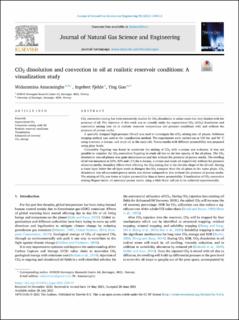| dc.contributor.author | Amarasinghe, Widuramina Sameendranath | |
| dc.contributor.author | Fjelde, Ingebret | |
| dc.contributor.author | Guo, Ying | |
| dc.date.accessioned | 2021-10-28T07:12:43Z | |
| dc.date.available | 2021-10-28T07:12:43Z | |
| dc.date.created | 2021-08-09T15:45:25Z | |
| dc.date.issued | 2021 | |
| dc.identifier.issn | 1875-5100 | |
| dc.identifier.uri | https://hdl.handle.net/11250/2826143 | |
| dc.description.abstract | CO2 convective mixing has been extensively studied for CO2 dissolution in saline water but very limited with the presence of oil. The objective of this work was to visually study the supercritical CO2 (sCO2) dissolution and convective mixing into oil at realistic reservoir temperature and pressure conditions with and without the presence of porous media.
A specially designed high-pressure 2D-cell was used to investigate the sCO2 mixing into oil phases. Schlieren imaging method was used as the visualization method. The experiments were carried out at 100 bar and 50 °C using n-octane, n-decane, and crude oil as the main oils. Porous media with different permeability was prepared using glass beads.
Convective fingering was found to accelerate the mixing of CO2 with n-octane and n-decane. It was not possible to visualize the CO2 convective fingering in crude oil due to the low opacity of the oil phase. The CO2 dissolution into oil phases was quite instantaneous and fast without the presence of porous media. The swelling of oil was measured as 55%, 50% and 11% for n-decane, n-octane and crude oil respectively without the presence of porous media. Boundary effects were affecting the CO2 mixing due to the circular shape of the 2D-cell. Having a water layer below the oil layer tends to dampen the CO2 transport from the oil phase to the water phase. CO2 dissolution into oil saturated porous media was slower compared to that without the presence of porous media. The mixing of CO2 was faster at higher permeability than at lower permeability. Visualization of CO2 convective mixing/fingers inside oil-saturated porous media using a Hele-Shaw cell yet to be achieved experimentally. | en_US |
| dc.language.iso | eng | en_US |
| dc.rights | Navngivelse 4.0 Internasjonal | * |
| dc.rights.uri | http://creativecommons.org/licenses/by/4.0/deed.no | * |
| dc.subject | Karbonlagring | en_US |
| dc.subject | Carbon storage | en_US |
| dc.subject | Økt oljeutvinning | en_US |
| dc.subject | Enhanced Oil Recovery | en_US |
| dc.title | CO2 Dissolution and Convection in Oil at Realistic Reservoir Conditions: A Visualization Study. | en_US |
| dc.type | Peer reviewed | en_US |
| dc.type | Journal article | en_US |
| dc.rights.holder | Copyright © 2021, Authors | |
| dc.description.version | publishedVersion | en_US |
| cristin.ispublished | true | |
| cristin.fulltext | original | |
| cristin.qualitycode | 1 | |
| dc.identifier.doi | 10.1016/j.jngse.2021.104113 | |
| dc.identifier.cristin | 1924827 | |
| dc.source.journal | Journal of Natural Gas Science and Engineering | en_US |
| dc.subject.nsi | VDP::Petroleumsgeologi og -geofysikk: 464 | en_US |
| dc.subject.nsi | VDP::Petroleum geology and geophysics: 464 | en_US |

